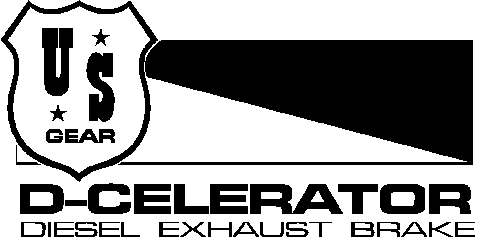

D-Celerator?
Frequently Asked Questions
What is the warranty on the
D-Celerator?
U.S. Gear warrants the product from defect for one full year, with unlimited mileage,
from the date of purchase. The warranty covers 100% of parts, 100% of labor, and all
freight charges. A copy of the written warranty is included with each product.

Since the D-Celerator exhaust brake bleeds off excess pressure through the waste gate, the D-Celerator will give you braking performance at lower RPMs while protecting the engine from over-pressure at higher RPMs. This feature is similar to the waste-gate on a turbocharger. (Click on the thumbnail image of the graph to view the full-size chart representing the benefit of a wasted-gated exhaust brake.)
Do I have to change my engine valve springs?Since none of the other brands are waste-gated, they require heavier valve springs to get braking performance so that they can close the exhaust more than the standard 75-80%. Since the D-Celerator always closes off 100% when activated and controls back-pressure, you get powerful braking without the costly addition of changing the valve springs. And let’s not forget when you add heavy duty valve springs to the engine, it means the engine works harder all the time causing an increase in parasitic loss and faster cam wear.
Is the D-Celerator effective behind
automatic transmissions?
Absolutely! The D-Celerator outperforms all other exhaust brakes behind automatic
transmissions due to the patented waste-gate bypass. The design allows us to develop more
braking horsepower at lower RPMs. The high amount of braking horsepower we develop has a
positive effect on the lock-up torque converter of automatic transmissions; therefore,
giving only the D-Celerator very effective braking with automatic transmissions.
Does the exhaust brake work when I’m
in overdrive in an automatic transmission?
No one’s exhaust brake will perform when the automatic transmission is in
overdrive. This is because of a feature that all four speed automatic transmission with
overdrive manufacturers have in fourth gear. It’s called "coast clutch" and
it disengages the engine from the rear wheels any time your foot is not on the throttle.
Since an exhaust brake can only be engaged when your foot is not on the throttle, any pressure being developed cannot be transferred to the rear wheels when coast clutch (overdrive) is engaged. Therefore, anytime you want engine braking, the overdrive must be disengaged.
Why does the D-Celerator not bolt
to the back of the turbocharger like other brands?
All exhaust brakes are designed to enhance the driving experience by giving the
operator the added security of braking assistance. The difference is in how the unit
is engineered. Will the exhaust brake interfere with the operation of the vehicle's
other systems? The turbo-mounted exhaust brakes offered restrict exhaust flow by
25%. This is because the stock pipe (or casting) they remove behind the turbo is empty,
but the replacement exhaust brake casting has parts in it.
Why do the other competitors mount there? Simply due to ease of installation and less cost. They remove a casting on the back of the turbo and replace it with a piece the same size. (Read Alert - an article which raises many questions about the design of turbo-mounted exhaust brakes.)
We take a different approach. We also have internal components in our exhaust brake, but we compensate by oversizing the casting bore. There is no room between the back of the turbo and the firewall to make the exhaust brake casting larger. Therefore to do it properly, we mount the larger diameter exhaust brake downstream in the exhaust system where there is clearance for the oversized casting.
For those who are worried that mounting the exhaust brake under the vehicle would make it more susceptible to dirt, water, or other debris, the D-Celerator is made up of T304 stainless steel material (excluding the iron casting). The stainless steel will resist corrosion or rust which will deliver years and years of trouble-free service.
How difficult is the installation? Can I
do it myself?
The installation on a front-engine vehicle is relatively simple. You simply remove
approximately 8" from the exhaust system anywhere ahead of the muffler. Then clamp
the D-Celerator in the section that was removed. Run the harness supplied in the kit from
the unit through the engine compartment and into the driving compartment for the driver
controls. Installation time is generally 2-3 hours.
On a rear-engine (pusher) vehicle, since the exhaust system between the engine and muffler is very short and has numerous bends, a lot of times installation will require some sort of fabrication. This would require some additional clamps and pre-bent tubing of different degrees. We recommend that in this application, installation be performed by authorized installation centers.
Does the D-Celerator work like a "jake
brake"?
No. The only thing that a "jake brake" and the D-Celerator have in common
is that both will slow the vehicle down. A "jake brake" is a compression brake
that is installed in the heads of a diesel engine. Therefore, it is called and engine
brake. Engine brakes are outlawed in many mountain communities due to the excessive noise
produced when engaged.
The D-Celerator is installed in the exhaust system; therefore, it is known as an exhaust brake (not an engine brake). The exhaust brake is very quiet when engaged and is not outlawed in any community and can be used very effectively for retarding momentum.